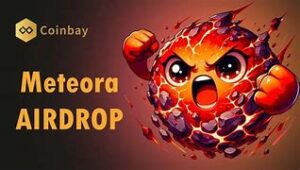The Meteora airdrop is gaining massive attention in the Solana ecosystem as one of the most rewarding token distributions of 2025. Designed to benefit real users and contributors, this airdrop involves participation in DeFi activities such as staking, liquidity provision, and governance within the Meteora platform.
This guide breaks down how the airdrop works, who qualifies, and what steps to follow to maximize your rewards.
What is Meteora?
Meteora is a DeFi protocol built on the Solana blockchain. It focuses on capital efficiency and liquidity optimization through a Dynamic Liquidity Market Maker (DLMM). Its mission is to strengthen decentralized finance by offering stable liquidity pools, staking rewards, and a sustainable economic model.
Meteora combines advanced DeFi mechanics with community-driven incentives, introducing tokens like M3M3 and MET to empower users and promote platform engagement.
What is the Meteora Airdrop?
The Meteora airdrop is a strategic token distribution event that rewards early adopters and consistent users. Instead of relying on random snapshots or luck, Meteora has designed a points-based eligibility system. Participants earn points for different activities on the platform, which later determine the amount of M3M3 or MET tokens they receive.
This method ensures that the airdrop rewards actual contributions and long-term involvement rather than speculative behavior.
How the Meteora Airdrop is Allocated
The airdrop is divided as follows:
- 10% of the total token supply is dedicated to Meteora users.
- 2% is earmarked for memecoin and community-driven stimulus initiatives.
- A portion is reserved for long-term liquidity providers and governance participants based on on-chain activities.
This allocation structure emphasizes long-term value creation and rewards users who actively engage with the ecosystem.
How to Qualify for the Meteora Airdrop
To be eligible for the airdrop, users need to accumulate points through different forms of interaction with the Meteora platform.
1. Provide Liquidity
Users who deposit assets into Meteora’s liquidity pools earn points daily. For every $1 deposited, one point is earned per day. In addition, users receive 1,000 points for every $1 they earn in trading fees.
Liquidity providers are the backbone of DeFi, and this reward structure encourages deep and stable liquidity on the platform.
2. Stake M3M3 Tokens
Staking is another essential activity. By locking M3M3 tokens on the platform:
- Users become eligible for fee-based rewards in M3M3.
- They earn bonus points for the airdrop, with top stakers receiving a higher share.
- There is a lock-in period, ensuring long-term engagement.
Meteora’s staking model promotes a healthy balance between passive income and long-term platform sustainability.
3. Participate in Governance
Governance activity such as voting on proposals, engaging in forums, and helping shape the future of Meteora also earns points. This method encourages active involvement in decision-making processes.
Users who consistently participate in governance are more likely to be rewarded in the airdrop distribution.
4. Use the Airdrop Checker
Meteora provides an official Airdrop Checker tool that allows users to assess their eligibility. This tool calculates your total points based on staking, liquidity, and other ecosystem engagements. While it does not guarantee a specific reward, it helps track your progress toward qualification.
Airdrop Distribution and Timeline
The Meteora airdrop operates on a phased timeline with tiered point systems:
- 8% of tokens were allocated to users between December 2023 and December 2024.
- 5% will be distributed to users who engage between January 2025 and the Token Generation Event (TGE).
- 2% will be rewarded to long-term liquidity providers and contributors active between December 2023 and April 2024.
This structure provides long-term incentives and benefits to both early adopters and consistent supporters.
How to Claim Your Meteora Airdrop
To claim the airdrop, follow these steps:
- Visit the official Meteora platform.
- Connect a Solana-compatible Web3 wallet (e.g., Phantom, Solflare).
- Use the Airdrop Checker to verify your eligibility.
- If eligible, follow the steps to claim your M3M3 or MET tokens.
- Optionally, stake the claimed tokens for additional rewards.
Make sure to stay updated with official Meteora announcements to avoid missing key claim deadlines.
Security Tips
When participating in airdrops, security is crucial:
- Only use the official Meteora website to connect your wallet.
- Be cautious of phishing scams and unofficial platforms.
- Double-check all URLs and use trusted wallets.
Never share your seed phrase or private keys with anyone, regardless of the context.
How to Maximize Your Meteora Airdrop Rewards
To get the most out of the airdrop:
- Continue staking M3M3 and providing liquidity regularly.
- Monitor your points and stay above the average score.
- Engage in governance activities consistently.
- Follow Meteora on social channels to stay informed.
By building a strong and active profile within the Meteora ecosystem, you position yourself for maximum token rewards during the distribution phase.
Conclusion
The Meteora airdrop is more than just a token giveaway; it’s a reward for long-term engagement and value creation within the DeFi ecosystem. With a transparent point system and multiple participation paths—staking, liquidity, and governance—this airdrop reflects a shift toward meaningful crypto incentives.
If you’re already active on Solana or looking to start, Meteora offers a promising gateway into a high-utility, community-focused DeFi protocol. Take advantage of this opportunity while it’s still early, and secure your share of M3M3 and MET tokens today.
Also Read:Ethereum Price Prediction 2040: Expert Forecasts & Analysis
